In early July, firefighters were battling two large blazes in Northern California and forecasters were warning of record heat and gusty winds that could stir up more trouble. Then the Holiday fire hit Santa Barbara County, destroying homes and forcing evacuations. In the middle of the month, the Ferguson fire west of Yosemite National Park doubled in size in one night, forcing crews to scramble to set up defenses. Then came the Cranston fire south of Idyllwild and the deadly Carr fire in Redding. By the end of July, wildfires across the state had killed eight people and scorched 200,000 acres.
As August began, the Mendocino Complex fire north of San Francisco exploded to 290,000 acres, making it the largest fire on record in California. Prolonged drought and extreme heat have made California ripe for dangerous fire conditions in recent months and years. Of the five largest wildfires in state history, four have occurred since 2012.
- Share via
California’s largest wildfire continues to burn, prompting additional evacuations
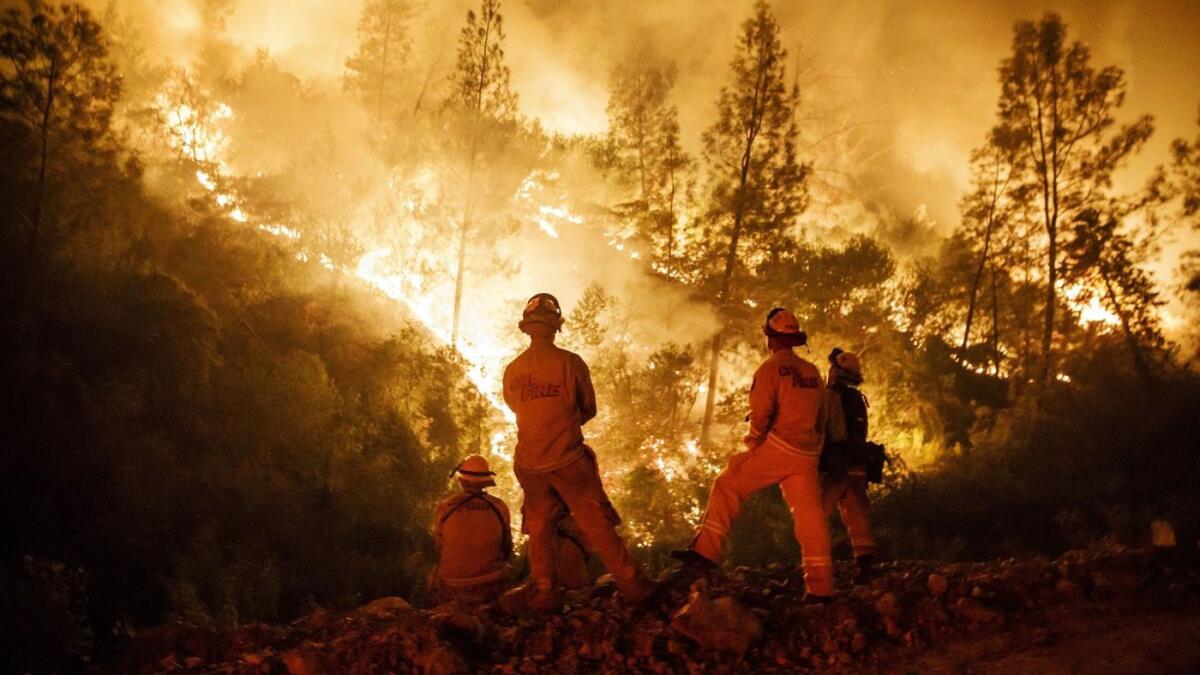
The Mendocino Complex fire — the largest wildfire in modern California history — continued to grow overnight into Monday, prompting evacuations in Glenn County.
Officials issued a mandatory evacuation order Sunday night for areas west of County Road 306 to the Lake County line, including the Mendocino National Forest area from the Colusa County line to County Road 308. Portions of Lake, Mendocino and Colusa counties remain under mandatory evacuation, according to the California Department of Forestry and Fire Protection.
The Ranch and River fires, which make up the Mendocino Complex fire, had burned 398,862 acres as of Monday morning. Firefighters are treating the Ranch and River fires as one event, even though the two fires have not merged.
- Share via
Interior secretary blames intensity of California wildfires on ‘environmental terrorist groups’
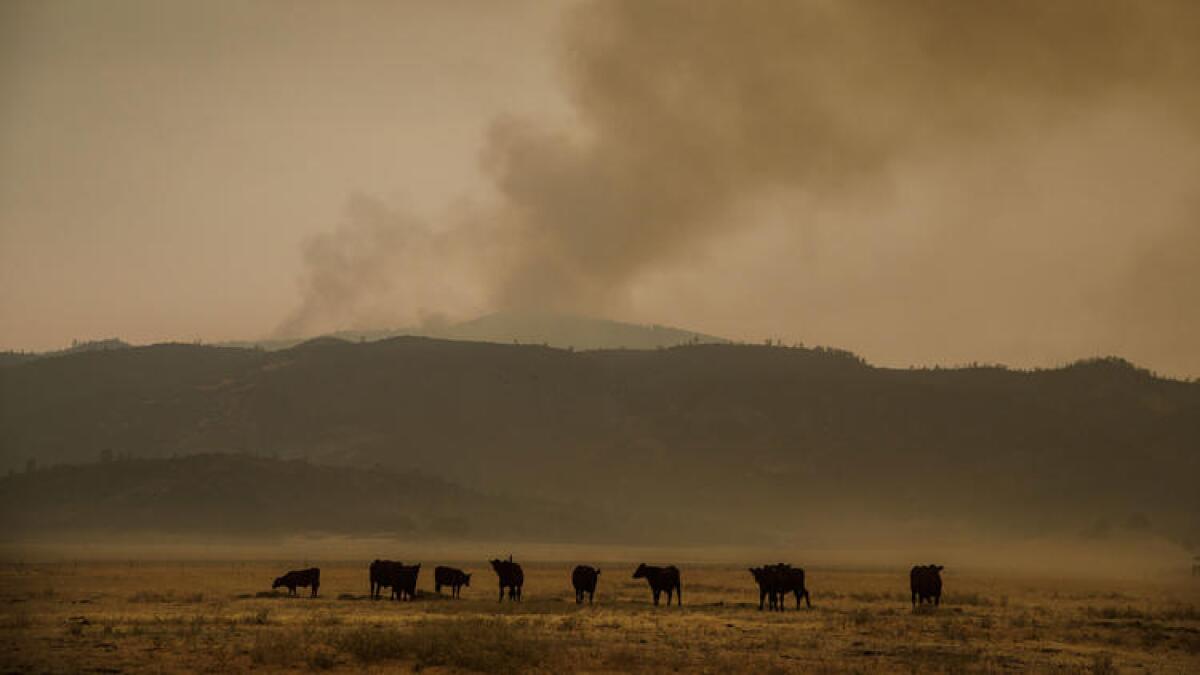
Wildfires strike California every year. But they’re getting worse, causing deaths and uprooting communities. Who’s to blame for these increasingly destructive wildfires?
According to Interior Secretary Ryan Zinke, it’s “environmental terrorist groups.”
During a radio interview with Breitbart News, Zinke said that “environmental terrorist groups” are preventing the government from managing forests and are largely responsible for the severity of the fires. But fire scientists and forestry experts pointed out that climate change is the main factor behind the problem.
Zinke claimed during the interview that an overabundance of fuel load — things like twigs and leaves that make it possible for fires to burn — make fires more intense.
- Share via
Why California’s largest fire in history is so difficult to contain
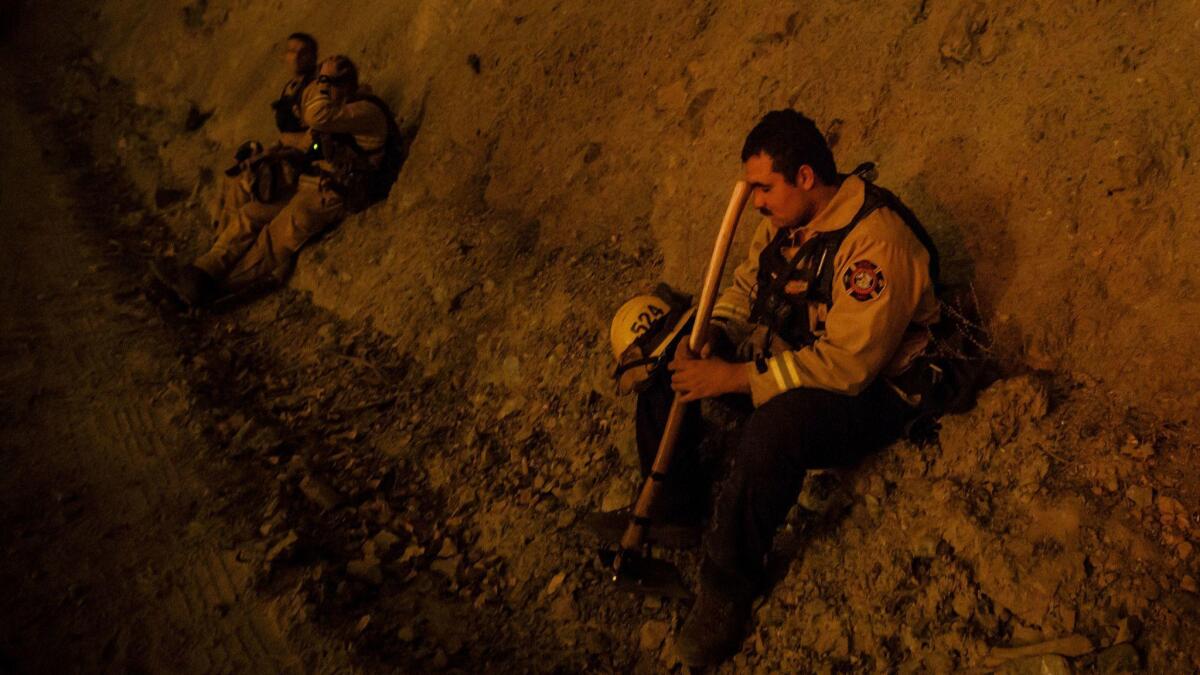
Each day on the front lines of California’s largest wildfire, firefighters start their shifts noting their safety zones and escape routes. Flames from the Mendocino Complex are still ripping through thousands of acres a day of steep, mountainous terrain packed with dead oak trees — standing and fallen — and littered with leaves and pine needles.
Crews are on especially high alert this week after a firefighter who traveled from Draper City, Utah, to help battle the blaze died Monday while working on an active stretch. Every five or 10 minutes, they’re encouraged to “look up, look around and make a sound.”
Conditions have been ripe for the erratic fire behavior that has led to explosive growth of the Ranch fire, which along with the River fire makes up the 364,145-acre Mendocino Complex. The days are so hot and dry that whatever gains firefighters see overnight when the humidity goes up quickly fade when the sun hits the fuels and sucks the moisture out. Lately, winds have started to pick up about 5 p.m., gusting between 15 mph and 25 mph.
- Share via
California’s largest fire keeps growing
The largest fire in California history continued to grow Wednesday while firefighters worked to protect threatened communities.
As of Wednesday morning, the Ranch fire had consumed 314,925 acres and was 64% contained. It has destroyed 147 homes so far. One firefighter, Matthew Burchett, 42, of Draper City, Utah, has died battling the fire.
The Ranch fire is one of two fires that form the Mendocino Complex fire. Firefighters were still monitoring the smaller of the two, the River fire, which as of Monday was 100% contained.
Residents around Clearlake have been allowed to return home, but new evacuation orders were announced in the last few days for communities to the east and west of Mendocino National Forest, including Stonyford, Lodoga and Potter Valley.
- Share via
Yosemite reopens to a surreal scene of smoke, tourists and flames in the distance
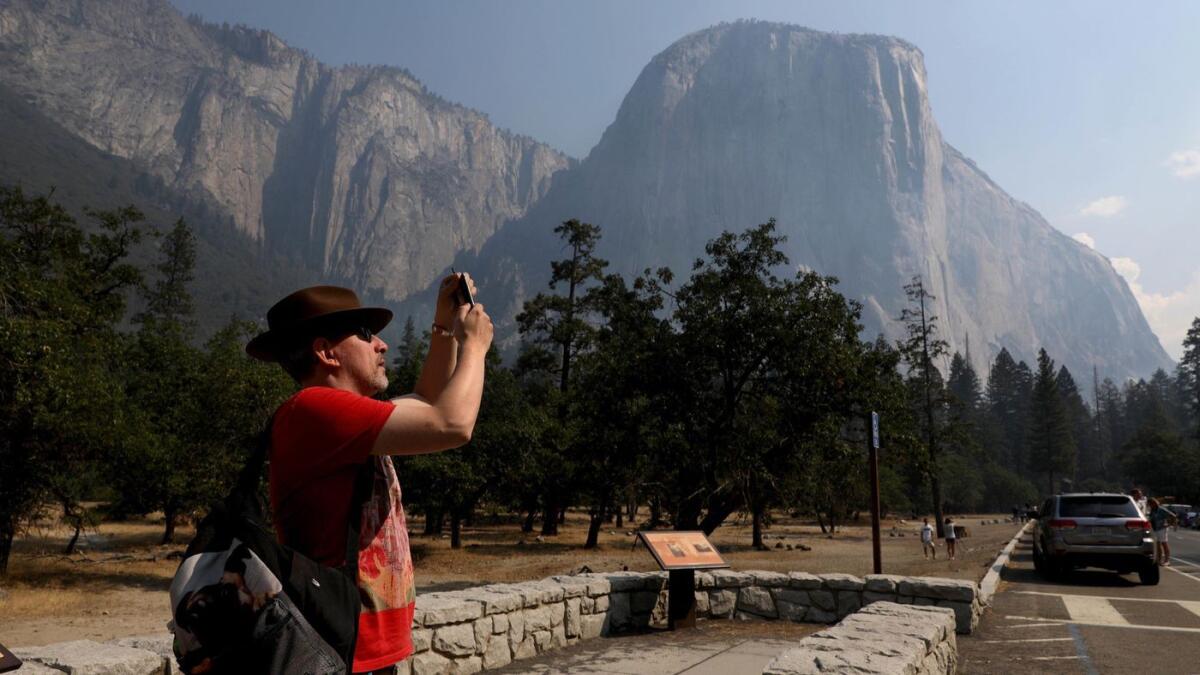
As Rob Walker drove into Yosemite, he briefly reconsidered the camping trip he was about to take with a small group of friends and family.
The outing is a tradition. Walker’s family always stays at the North Pines Campground near the Merced River, with Kaleigh Burn and her family.
But on Tuesday, the group had a moment when, impressed by the power of the Ferguson fire, they were unsure.
“We came through on Highway 140 — active fire is still going on right there,” said Walker, 49, of Mission Viejo. “You see the smoke and flames, and you just want to turn around. But once you get through that area, it’s beautiful — it’s smoky — but you’re still here at Yosemite.”
The valley reopened Tuesday after being closed since July 25 due to the deadly fire burning in nearby forestland. It was a surreal scene as thousands of visitors streamed into the nearly empty park, passing by the flames and surveying the iconic vistas shaded by a smoky haze.
Yosemite is one of several spots across California to be altered by a hellish summer of fire and heat that has left 11 people dead and destroyed more than 1,000 homes from Redding to San Diego.
- Share via
Track the key details on California’s fires
- Share via
Utah firefighter who died battling Mendocino Complex fire is identified as Matthew Burchett
- Share via
Yosemite Valley reopens as firefighters strengthen containment of Ferguson fire
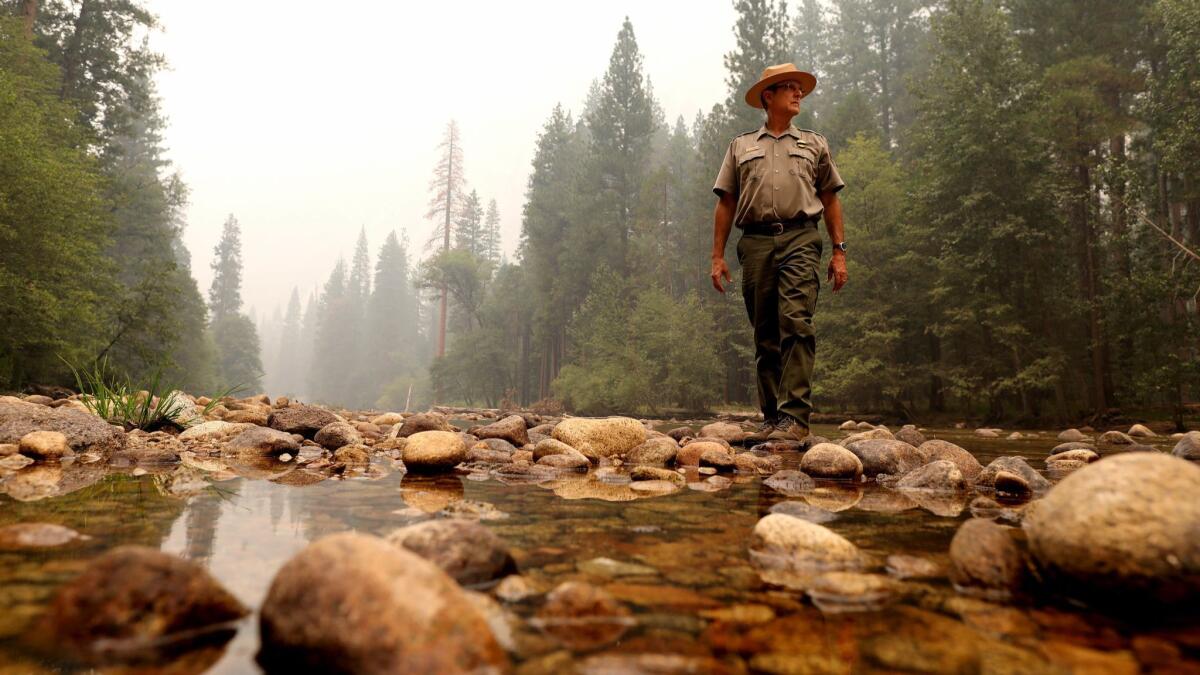
Yosemite Valley was reopened for the first time in weeks on Tuesday morning, but some visitors may have been surprised to see a burning hillside along El Portal Road, a key entryway into the famed glacial valley.
Officials at Yosemite National Park had listed the official reopening time as 9 a.m., but a steady stream of light traffic began entering the valley hours earlier.
On Monday evening, helicopter crews worked steadily to stamp out the Ferguson fire as it burned along a hillside near the Merced River. They repeatedly maneuvered their buckets down into the river, avoiding nearby boulders and trees.
Highway 140, which becomes El Portal Road once inside the park, will be one of the only open routes into Yosemite Valley on Tuesday. But it’s also near one of the last challenges that firefighters face in ending the Ferguson fire.
“That’s the last active part of the fire for the Ferguson fire,” said Tom Efird, an incident information officer. “It remains within the [containment] lines, so we’re just actively working on mopping it up and making sure it doesn’t spot over the containment lines and create any more problems for us.”
- Share via
More than 50% of this California county has burned since 2012. Some residents say they’ve had enough
Clarence Sibsey sat alone at a table in the Twin Pine Casino evacuation center, tired and dejected.
Once again, a fire was threatening his community and he had to leave home. Two years ago, he fled the massive Valley fire. Now he had been driven away by the Mendocino Complex fire, which at more than 340,000 acres is the biggest in California history.
“We’ve never had fires like this before,” Sibsey said. “Why now?”
The battle to control the massive blaze continued Monday, as officials announced the death of a Utah firefighter on the front lines. The unidentified firefighter was airlifted to a hospital, where he died. Authorities said “fact-finding on the accident” was underway.
The news came amid progress in containing the fire, which enabled more residents to return home.
But the blaze has been a grim reminder for Lake County residents of how their area is now an epicenter for fires.
A Los Angeles Times analysis found that more than 50% of the county’s land has been burned since 2012. And it has sparked debate for some residents about whether living in this rural enclave about 120 miles north of San Francisco is worth it.
- Share via
When fires hit and pets go missing, this San Diego crew hits the road
Kenneth Bettencourt used to search for missing people and investigate homicides.
These days, he’s the guy you may call if your dog runs away.
“I’ve always loved animals, and when I retired in ’95, my wife said, ‘You’ve got to find something else to do,’” the former police detective said.
Bettencourt, 78, formed Animal Rescue Shelter and Patrol in 2013, using the garage of his home in the community of Del Mar Heights as a kennel to hold stray pets he found until they were reunited with their owners.
About six months ago, his nonprofit merged with the United States Service Command of America, an Illinois-based nonprofit that has focused mostly on disaster relief.
Under the new venture, Bettencourt said he has put together a canine rescue team that will be used to find people trapped in collapsed buildings and other emergency situations. He is working with a trainer who so far has put together a team of about five people, he said.
He also has added a new team that will consist of volunteers certified through training with the Society for the Prevention of Cruelty to Animals to help law enforcement during wildfires and other emergencies. Besides helping direct traffic and performing other duties, the team will try to corral any pets that may have fled and are in danger.
- Share via
Firefighter dies battling Mendocino Complex, largest wildfire in California
A firefighter died Monday battling the largest wildfire in recorded California history, marking the latest fatality in a fire season that has taken a grim toll on first-responders.
The California Department of Forestry and Fire Protection said Monday evening that it was “deeply saddened” to report the death of a firefighter battling the Mendocino Complex fire.
The firefighter was not named, and authorities said “fact finding on the accident” is underway.
The series of firestorms that erupted across the state amid scorching heat and bone-dry conditions have taken a devastating toll on fire crews.
A Redding firefighter, a bulldozer operator and a Pacific Gas & Electric utility worker have died during the Carr fire, which has destroyed more than 1,000 homes in Shasta County. Two more firefighters died while battling the Ferguson fire in Yosemite.
A mechanic with the California Department of Forestry and Fire Protection who had been assigned to the Carr fire also died in a vehicle crash in Tehama County.
- Share via
Cooler temperatures aid battle against California wildfires, but smoke continues to choke Central Valley
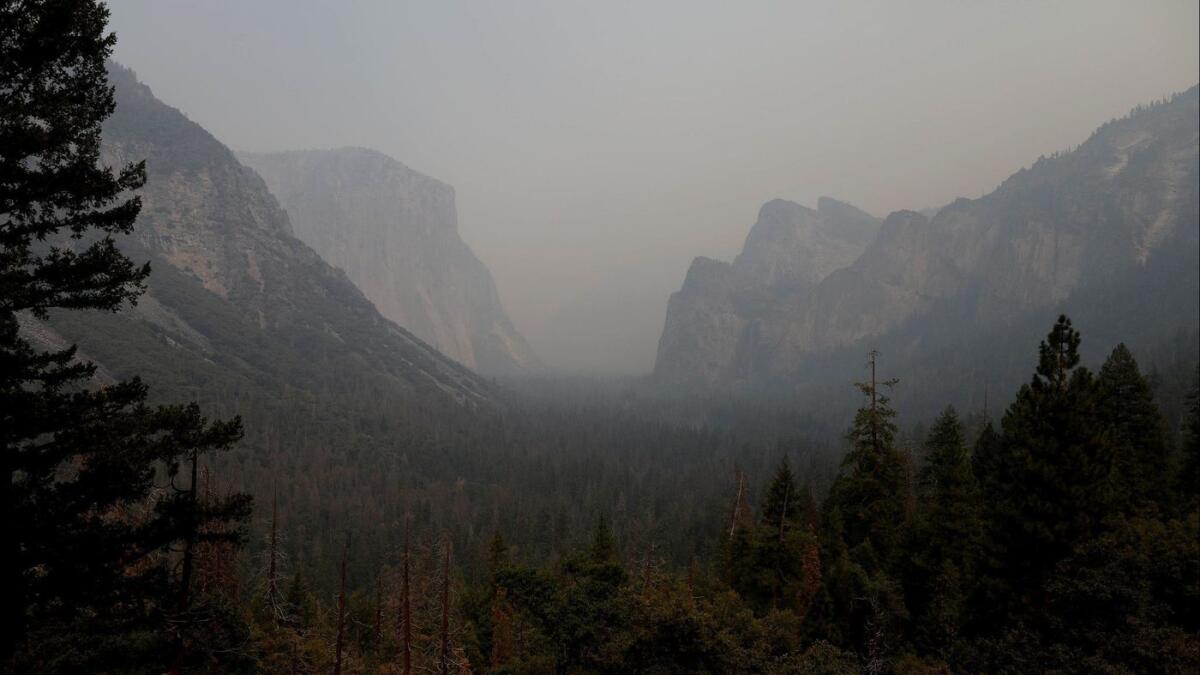
Although a break in the weather has provided firefighters a respite from the scorching heat that has complicated the fight against multiple wildfires in California, an alert warning of poor air quality remains in effect for much of the Central Valley, the National Weather Service said.
The San Joaquin Valley Air Pollution Control District warned of poor air quality in Stanislaus, Merced, Madera, Fresno, Tulare, Kings and Kern counties, the east side of the San Joaquin Valley and the Sierra Nevada and foothill areas due to smoke from the Ferguson fire.
Air pollution control districts in Mariposa and Tuolumne counties have also issued air quality alerts, which will be in effect until the fire is extinguished. The Ferguson fire has scorched 96,457 acres and is 86% contained. The fire has also claimed the lives of a Cal Fire bulldozer operator and a captain of the Arrowhead Interagency Hotshots.
Exposure to particle pollution can cause serious health problems, aggravate lung disease, cause asthma attacks and acute bronchitis, and increase risk of respiratory infections, the weather service said.
- Share via
‘It’s all going to burn’: Man accused of setting Holy fire was a well-known troublemaker, neighbors say

Mike Milligan had poor reception in the Holy Jim canyons and foothills when his phone buzzed with a confusing text message: “911 call sheriff.”
The sender was a longtime Trabuco Canyon resident named Forrest Gordon Clark, an eccentric figure well-known in the tightknit community as a troublemaker with a temper who had long clashed with his family and neighbors.
Concerned, the chief of the Holy Jim Volunteer Fire Department dialed Clark’s number, but the call failed.
Moments later, Milligan said, another text from Clark came through: “It’s all going to burn like you planned.”
Nearly three weeks later, Clark, 51, was taken into custody on a charge of arson, accused of setting the blaze now known as the Holy fire.
The massive wildfire erupted Aug. 6 in Holy Jim Canyon, tearing through more than 22,000 acres of bone-dry chaparral and brush in the Cleveland National Forest that hadn’t burned in decades. Thousands of residents and campers had to run for their lives, while more than 1,000 firefighters mounted an aggressive attack against the blaze. At least a dozen cabins were reduced to rubble.
- Share via
The Holy fire is 22,700 acres with 41% containment
- Share via
Fires across California
- Share via
Ignore the climate change deniers. California’s hellish summer really is a grave warning
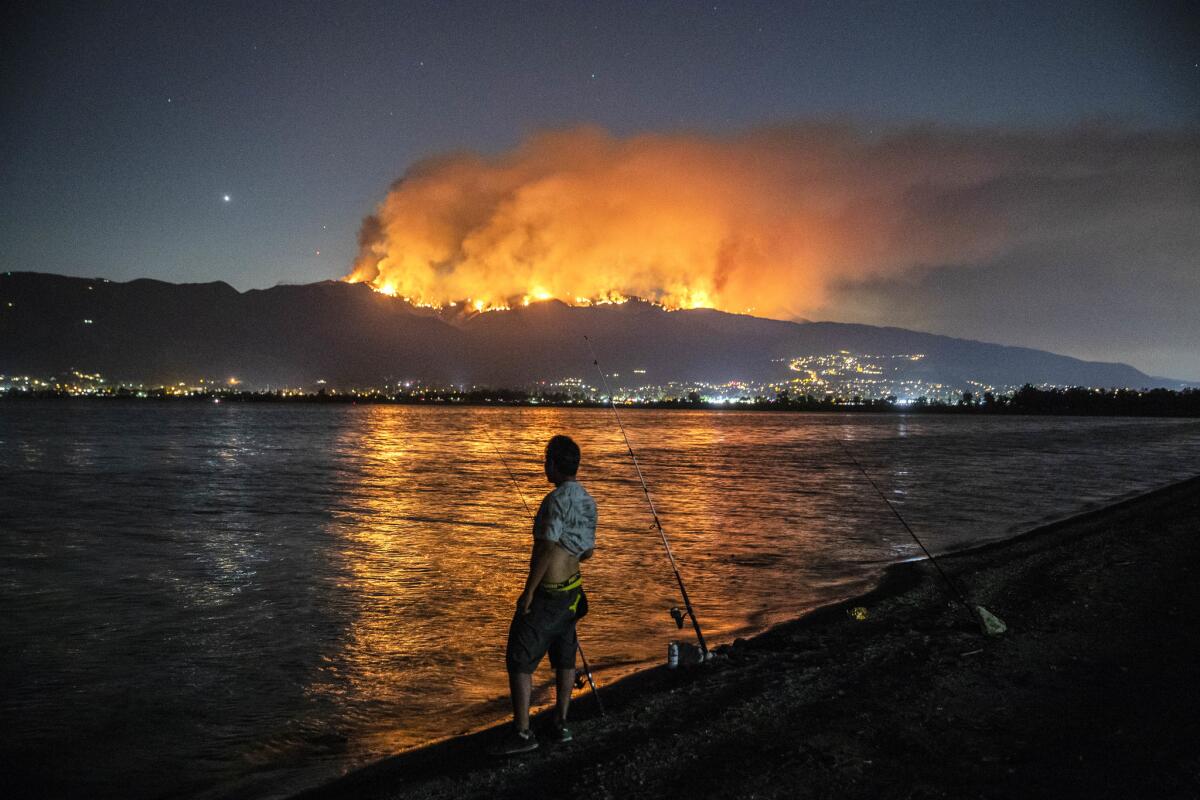
Wind-swept wildfires raging. Homes incinerated. Families displaced. Lives lost.
In the long, hot, smoky California summer of 2018, as we camp under ash-hued sunset skies, the scariest thought is that the future has arrived, and more intense weather extremes will continue to wreak havoc in years to come. Not just in summer, but with drought-deluge cycles and higher temperatures even in cooler months.
Last week, an 81-year-old Van Nuys resident told me that sure, summers have always been hot, but lately they seem to have been imported from Palm Springs.
Near Santa Cruz, a winery owner told me there are fewer foggy days and more high temperatures, shrinking what have long been prime grape-growing regions.
But not everyone is alarmed, it turns out, which I’ve discovered since my July 18 column on climate change. Reaction has fallen into the following categories:
There is no climate change, and I’m a stooge to have fallen for a hoax.
Global warming exists, but it’s not man-made.
Climate change is real, but it’s silly to believe California’s environmental zealotry can measurably improve a global problem.
And lastly, if climate change is real and it’s here, what can we do about it legislatively and individually?
- Share via
Holy fire containment increases to 29%
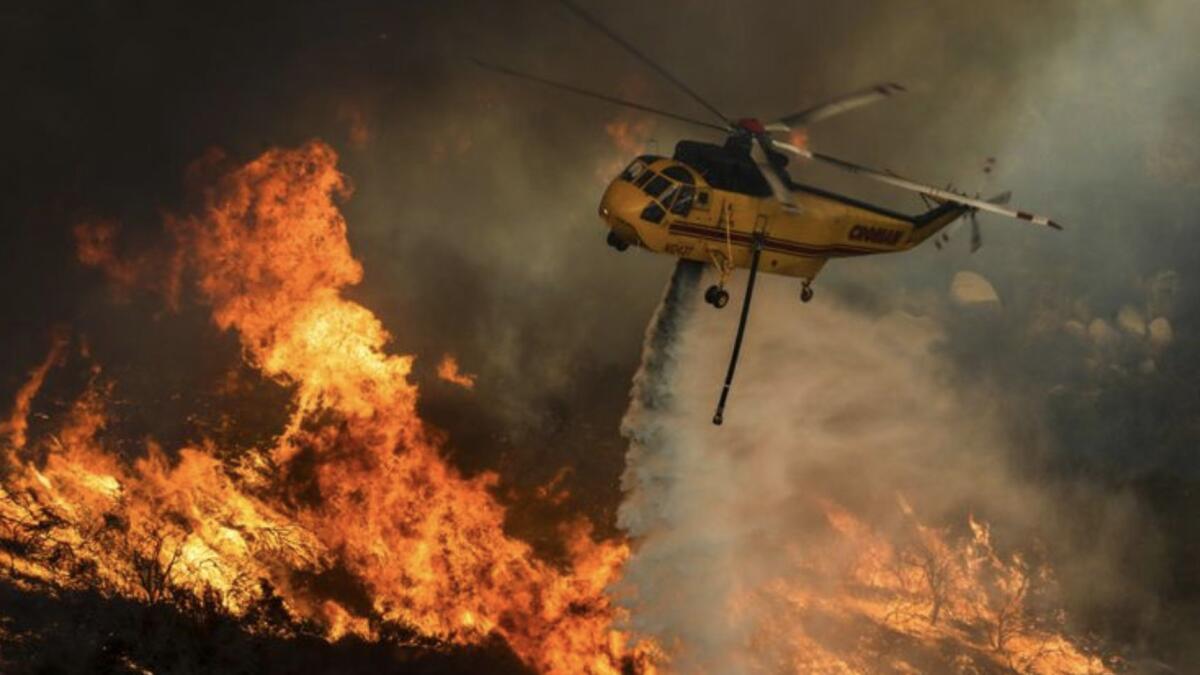
It’s been an epic aerial assault that is showing signs of success. By Saturday morning, containment of the Holy fire had jumped from 5% to 29% in less than 24 hours. Flames whipped dangerously close to Lake Elsinore suburban developments, but there has not been a major loss of housing so far.
The hot conditions and unpredictable weather has made it difficult for firefighters to get ahead of the fire. But they have one big advantage: easy access to the water from Lake Elsinore, which they have used for countless drops.
- Share via
Yosemite Valley to reopen Tuesday after nearby fires closed it for 20 days
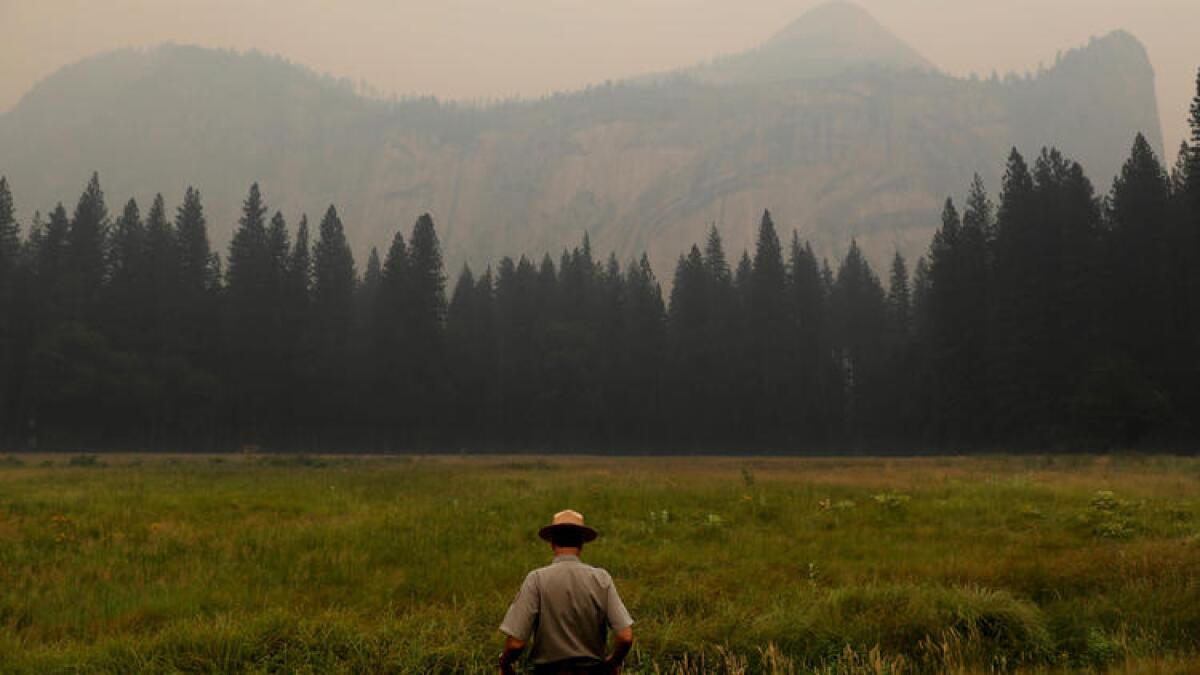
Yosemite Valley will reopen to visitors at 9 a.m. Tuesday, after being closed for 20 days because of the Ferguson fire. The National Park Service also announced Friday that the Mariposa Grove of Giant Sequoias will reopen at 9 a.m. Monday
Visitors should expect limited hours and services at park facilities as they return to normal operations.
- Share via
Carr fire path of destruction shown in aerial photos
Aerial photos collected as part of a multi-agency collaboration creates a view of the Redding, Calif., area and the Carr fire’s path of destruction. Licensed drone pilots from the Menlo Park Fire District, the Alameda County Sheriff’s Office, the Contra Costa Sheriff’s Office and other agencies assisted the city of Redding in capturing the aerial photos. Click through to see all photos.
- Share via
Arson suspect in 18,000-acre Holy fire makes brief court appearance; arraignment is postponed

The man accused of setting the 18,000-acre Holy fire in Orange County that prompted thousands of residents to evacuate their homes this week made his initial court appearance Friday.
Forrest Gordon Clark, 51, made several outbursts during the hearing in Santa Ana, calling the charges against him a “lie,” and insisting again that he was being threatened, according to City News Service.
When a court commissioner ordered his bail to remain at $1 million, Clark said he could easily afford it. His arraignment was postponed until Aug. 17.
Clark, who has been charged with multiple counts of arson in connection with the Holy fire, originally was scheduled to appear in court Thursday but refused to leave his jail cell, according to Carrie Braun, public information officer for the Orange County Sheriff’s Department.
- Share via
Need to pack for an evacuation? Here’s a list of essentials to take with you
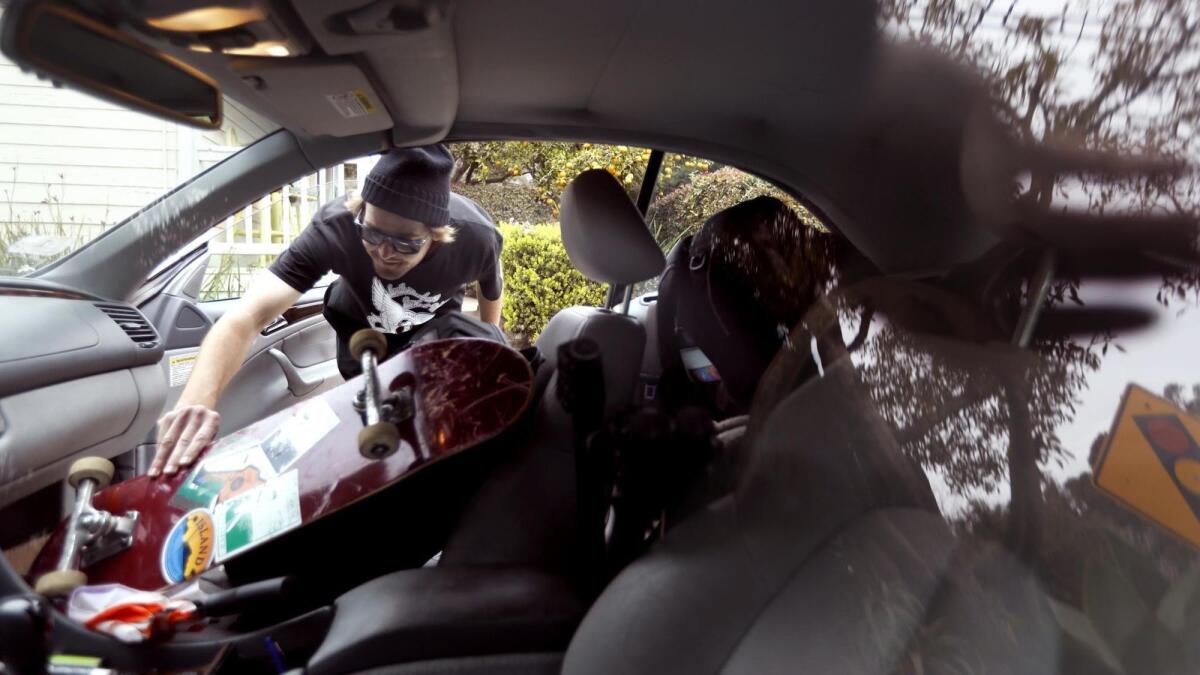
One key to getting through any emergency situation is preparation.
With wildfires raging across California, more and more residents are being faced with having to evacuate. The Mendocino Complex fire is now the largest wildfire in state history, a record previously held by last year’s Thomas fire.
The first thing to pack should be your “go bag” of essentials. That, experts say, should include:
- Water and nonperishable food
- A flashlight
- A first aid kit
- Batteries and chargers for your devices
- Several days’ worth of clothing — including coats, pajamas, underwear and socks
- Moist towelettes, garbage bags and plastic ties for sanitation purposes
- A battery- or crank-operated radio
- A whistle to signal for help
- Local maps in case GPS isn’t working
- Share via
15 fires burn across California
- Share via
Here is the latest map of the Holy fire, which has grown to more than 18,000 acres
By Friday morning, the Holy fire had grown to 18,137 acres and was 5% contained.
- Share via
A staggering death toll for firefighters in California’s summer of flames
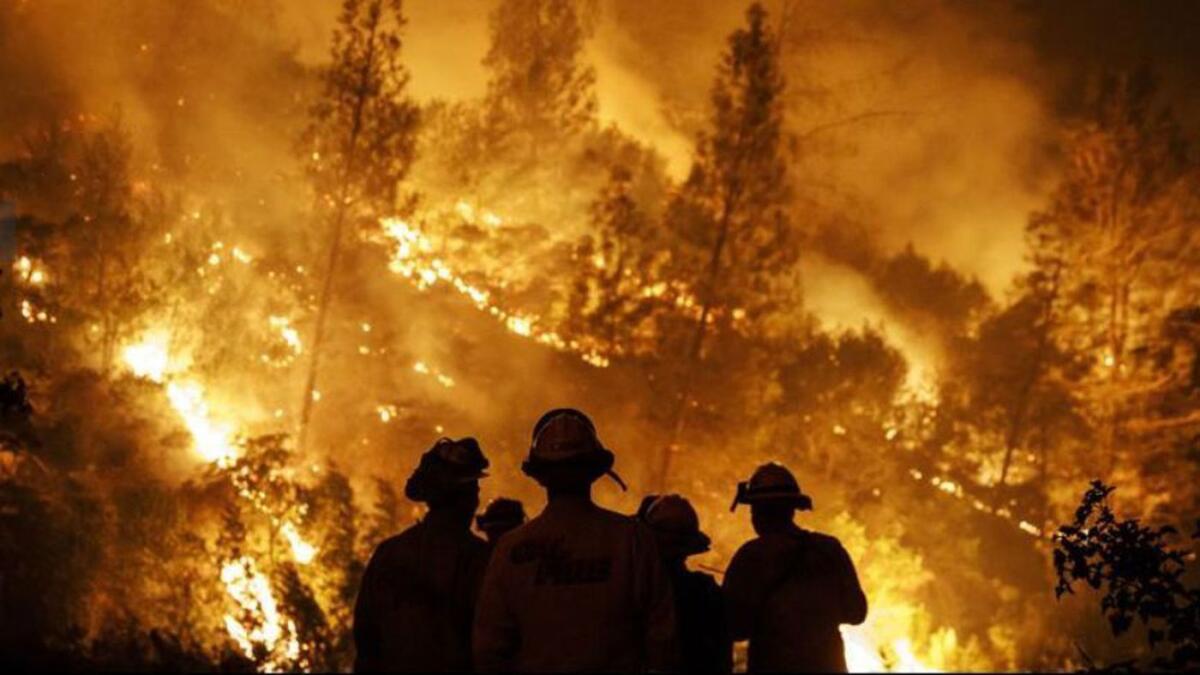
Ben Newburn faced a group of weary firefighters gathered a few mornings ago with one message: safety before anything else.
The veteran fire management officer for the U.S. Forest Service recounted the numerous firefighters who had lost their lives battling massive blazes in the region. There was Andrew Palmer, who died 10 years ago while clearing trees. And the nine firefighters killed in 2008 when their helicopter crashed in the Shasta-Trinity National Forest, an incident seared in history as the “Iron 44 tragedy.”
“This country … chews up firefighters. It has had a notorious past of being very hard on us,” Newburn said. “So as you guys are going out there, working on whatever assignment you guys have, please keep in mind what you’re doing and the risks associated with that.”
The firestorms in Redding and elsewhere across California have taken a grim toll on firefighters and other responders. A Redding firefighter, a bulldozer operator and a Pacific Gas & Electric utility worker have died during the Carr fire, which has destroyed more than 1,000 homes in Shasta County. Two more firefighters died while battling the Ferguson fire in Yosemite.
- Share via
Holy fire explodes to more than 18,000 acres
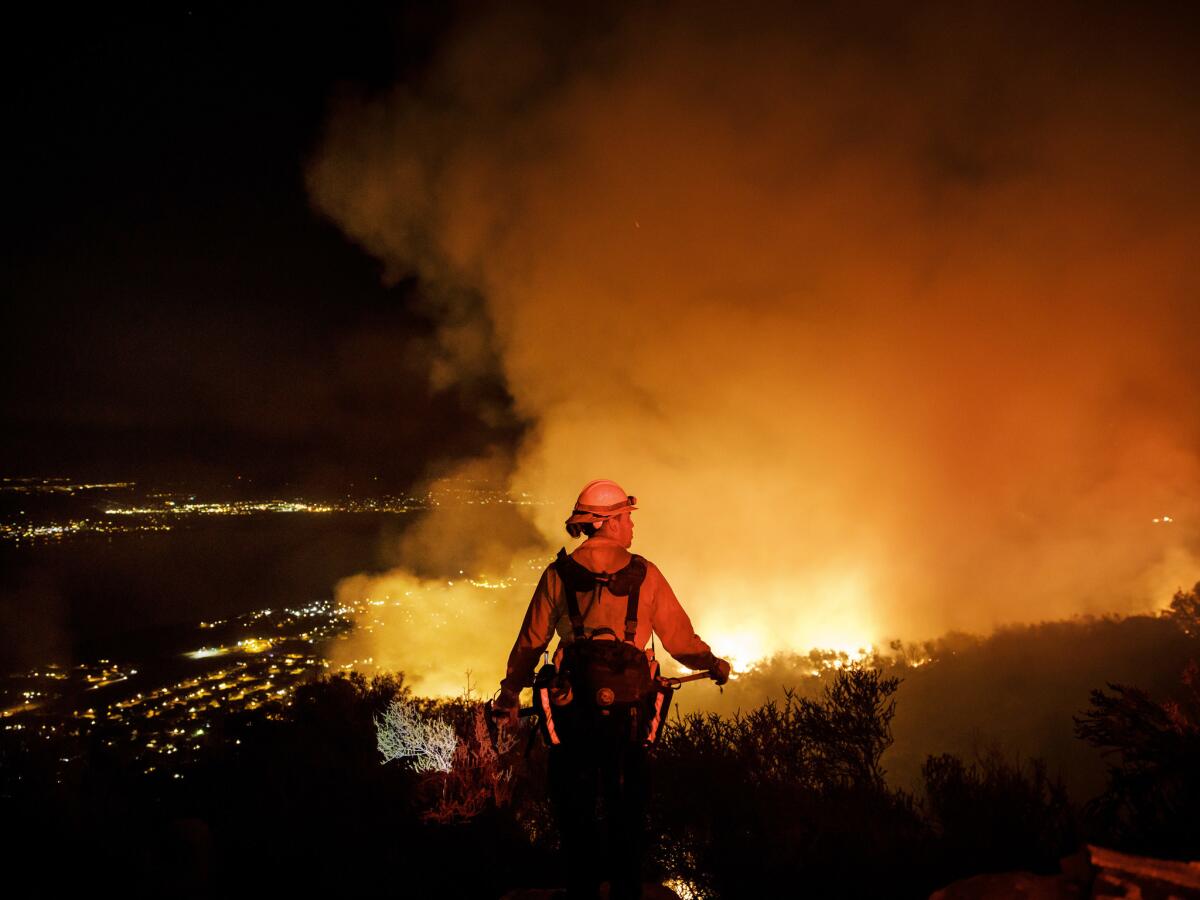
As flames flickered behind Ana Tran’s McVicker Canyon home, she and her friend rushed to their car and sped past firefighters who were heading toward the blaze. Thick black smoke billowed above homes and cars were blanketed in pinkish fire retardant.
The residents, like many others, made a frantic escape Thursday after winds picked up in Lake Elsinore and pushed the raging Holy fire within feet of homes. The blaze had ravaged more than 18,000 acres in the Cleveland National Forest and had spread into Riverside County as of Friday morning.
- Share via
‘We didn’t think it would get here,’ says a Lake Elsinore resident watching the flames
At the southern edge of the Holy fire in Lake Elsinore, where most of the activity was occurring Thursday night, the blaze moved toward hundreds of homes snuggled in and around the canyons that sit along Grand Avenue.
In the Robin Hood Oaks neighborhood, at the corner of Little John and Nottingham ways, Tera Swick, 43, watched from the frontyard of her mother’s home as large flames shot up. She and her family cheered on the aircraft that made drops of fire retardant.
“They’re just amazing,” she said. “We’re cheering them on every time they’re making drops.”
She said she and her family were going to evacuate but decided to wait before heading out. They had a small U-haul trailer stuffed with belongings.
“We’re just trying to stay until — well, let’s not even go there — until we can go back inside the house,” she said.
For the last few days, Swick has been keeping track of the fire.
“We didn’t think it would get here,” she said.
But wildfires this year have been massive and fast-moving. Taking that into account, Swick said she’s not surprised she is watching the canyons burning near her childhood home for the first time.
She said water and retardant drops have slowed the fire but have not kept it from advancing. Part of the problem, she said, is that there hasn’t been a fire in the area for many years.
Swick said she’s not too scared. Her father was a Cal Fire firefighter and led the first female inmate firefighters. she said.
Much of the time her mind is on the firefighters working to protect homes.
“These guys out here are the ones that deserve the attention,” she said. “They’re fighting so hard.”
Swick stood in the yard, her arms behind her head, watching the flames coming down the mountain.
“I don’t even know which way to watch,” she said.
It had been only two hours earlier when the fire seemed to slow, moving away from the neighborhood. But now ash was falling and the wind was picking up. A truck loaded with motorbikes and other valuables stood running on Nottingham Way, slowing down the movement of fire trucks.
“That guy has to move his truck,” Swick said.
Two minutes later a man came running down, apologizing and moving the truck.
Swick, her mother and brother-in-law sat by the driveway, waiting for authorities to finally force them to leave.
Just before 1 a.m., the flames that had been approaching Robin Hood Oaks had slowed down again. A helicopter continued to make water drops. Standing in the driveway, Swick had only one thing to say: “Better, it looks better.”
- Share via
Holy fire threatens Lake Elsinore, bringing evacuations; new fire near Ramona
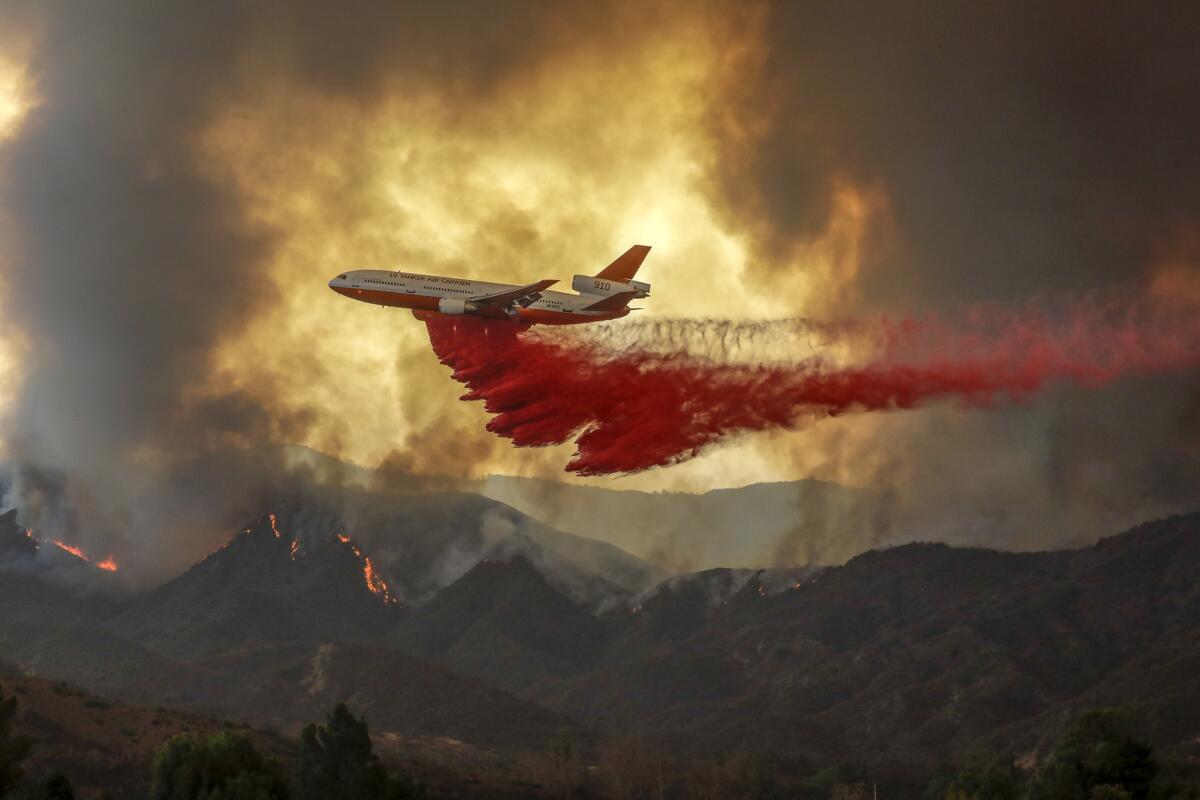
The Holy fire in the Cleveland National Forest marched toward Lake Elsinore on Thursday afternoon, forcing a new round of evacuations.
Residents living in homes on the mountainside of Lake Street and in the southeast region from Grand Avenue to Ortega Highway were told by the U.S. Forest Service to leave their homes immediately as the 9,600-acre fire moved their way.
To the south, the Rangeland fire broke out west of Ramona and quickly charred between 100 and 150 acres while threatening structures along a rural road.
- Share via
Here’s the latest map of the Holy fire
The Holy fire grew to 9,600 acres by Thursday morning, threatening homes near Lake Elsinore.
- Share via
Cal Fire mechanic dies near Carr fire, bringing death toll to 8 as crews battle blazes throughout California
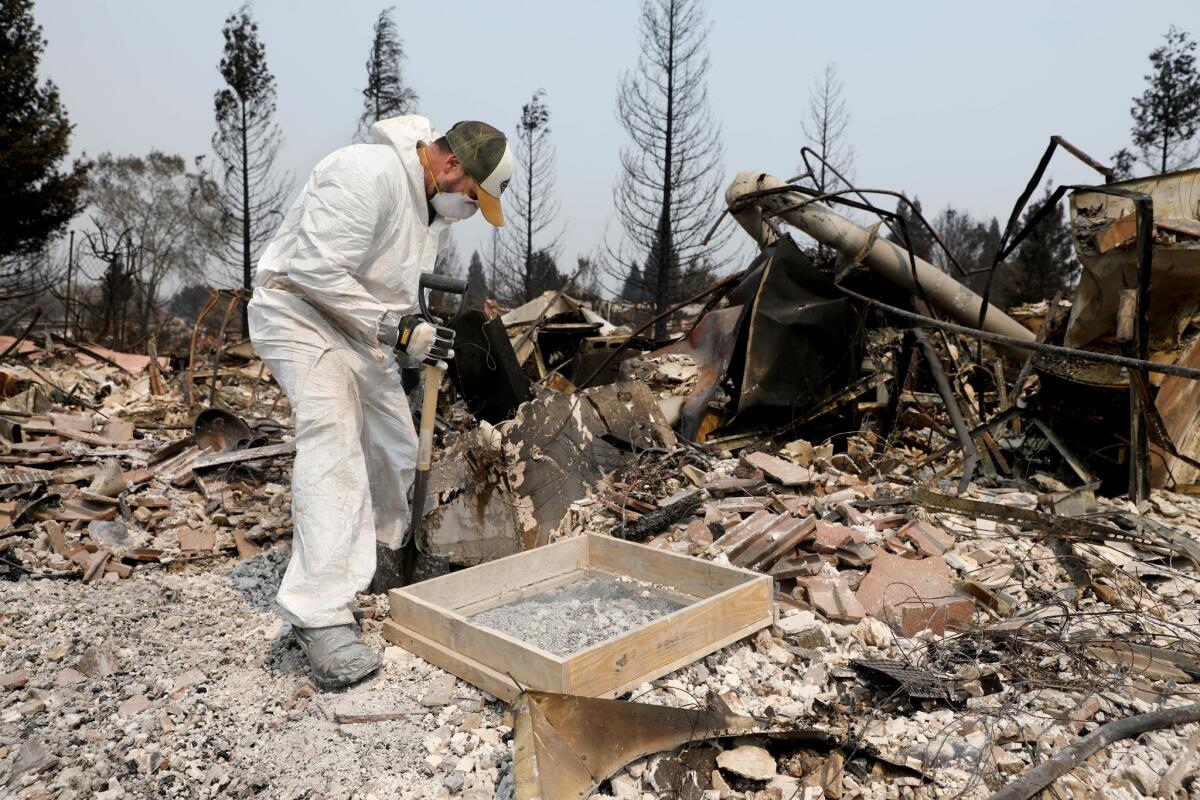
A Cal Fire mechanic assigned to the Carr fire died in a vehicle crash in Tehama County early Thursday morning, the eighth death connected to the furious blaze that has scorched roughly 177,000 acres in Northern California, officials said.
The victim, described as a heavy equipment mechanic, died in a crash on Highway 99, the California Department of Forestry and Fire Protection said in a statement.
The crash happened at 12:17 a.m. after a Dodge Ram 5500 veered off the highway’s right shoulder, slammed into a tree and caught fire, according to Officer Ken Reineman of the California Highway Patrol’s Red Bluff station. The victim’s identity has not been released.
The Carr fire has proved to be the most lethal in California this year. Four Redding residents, a Redding firefighter, a bulldozer operator and a Pacific Gas & Electric utility worker have also died in connection with the blaze, which has destroyed more than 1,000 homes, officials have said.
- Share via
Ready for an evacuation? What you might want to think about packing
One key to getting through any emergency situation is preparation.
With wildfires raging across California, more and more residents are being faced with having to evacuate. The Mendocino Complex fire is now the largest wildfire in state history, a record previously held by last year’s Thomas fire.
The first thing to pack should be your “go bag” of essentials. That, experts say, should include:
- Share via
They are fighting California’s biggest fire — in steep forest terrain with rattlesnakes, scorpions and poisonous plants
For Trey Rosenbalm and Ariana Altier, fighting the largest fire in California history takes more than just watching out for flames.
The Mendocino Complex fire is ravaging thick brush deep in the Mendocino National Forest, so getting close to the front lines to attack flames directly is almost impossible.
They hike several miles per day up steep slopes wearing hefty gear and carrying heavy bags of equipment on their backs. Then there’s the wildlife they have to watch out for — rattlesnakes, scorpions and poisonous plants.
- Share via
As Holy fire raged, arson suspect told newsman he had no idea how it started: ‘I was asleep, I had two earplugs in’
As the Holy fire raged nearby and forced residents to flee their homes, the man accused of setting the 6,200-acre blaze sat in front of a news camera and said he had no idea how it started.
“I have no idea. I was asleep, I had two earplugs in,” said Forrest Clark, according to a video obtained by ABC 7 Eyewitness News.
In the rambling interview, Clark told the cameraman that gangs were after him and that he’d been up for more than 20 days after visiting Mission Hospital in South Orange County.
- Share via
Life under California’s massive blanket of smoke
In an otherwise deserted part of Clearlake Oaks, which was under a mandatory evacuation order, Nicole Young sat on the porch of a triple-wide lakefront mobile home with a couple of other holdouts.
A sweet smell wafted outside from the home. Young, 44, was baking a yellow cake.
Its welcome scent competed with the smell of smoke, which has enveloped this little lakeside community for the past week, as the largest wildfire in state history — actually separate side-by-side blazes that have been dubbed the Mendocino Complex — rages on.
- Share via
California’s ‘new normal’ for wildfires is unacceptable
Please spare me all the political patter about California burning being the “new normal.” It’s really getting old.
If the new normal means week after week of smoky skies blotching our once-beautiful state, I don’t want to hear about it. Seeing and smelling is depressing enough.
If it means thousands of homes constantly being incinerated and people dying in flames, California is headed into ruins.
- Share via
New mandatory evacuations as Holy fire burns closer to some communities
The Holy fire in the Cleveland National Forest pushed closer to some homes Wednesday, prompting a new round of mandatory evacuations.
The fire, which has burned more than 4,000 acres, is forcing evacuations in Painted Canyon, McVickers, Rice Canyon, Horsethief, Glen Eden, El Cariso Village, Sycamore Creek, Syacmore Canyon and Rancho Capistrano, according to the National Forest Service.
The Ortega Highway corridor from Lookout Restaurant to Nichols Institute was also covered by the evacuation order.
- Share via
Following Trump, government uses California wildfires as excuse to attack endangered species protections
Just two days after President Trump issued an utterly uninformed tweet about the causes of the California wildfires, his ulterior motives began to come into focus.
That happened through an order issued Wednesday by Commerce Secretary Wilbur Ross to the National Marine Fisheries Service and its parent agency, the National Oceanic and Atmospheric Administration. Both fall under Ross’ jurisdiction.
The order directs the agencies to “facilitate access to the water needed to fight the ongoing wildfires affecting the State of California.” It then gives the game away by making specific reference to the federal Endangered Species Act: “Consistent with the emergency consultation provisions under the ESA, Federal agencies may use any water as necessary to protect life and property in the affected areas,” the order says.
- Share via
Here’s what the Mendocino Complex fire looks like overlaid on Los Angeles and New York
The Mendocino Complex fire is California’s largest wildfire on record, covering about 300,000 acres. It’s located around Clear Lake in Northern California and has mostly burned in wooded areas in hilly terrain.
But what does 300,000 acres look like? We mapped the fire over L.A. and New York to find out.
If it were in L.A., the fire’s perimeter would stretch from LAX to Pomona.
In New York it would easily cover Manhattan, Queens, Staten Island, and Newark and Jersey City, N.J. A lot of Brooklyn would also be covered.
- Share via
Man suspected of setting Holy fire is arrested while 18 wildfires continue to burn across California
A man suspected of starting the Holy fire in Orange County has been arrested, Cleveland National Forest officials announced Wedesday.
Forrest Gordon Clark, 51, was arrested on suspicion of two counts of felony arson, one count of felony threat to terrorize and one count of misdemeanor resisting arrest in connection with the ignition of the Holy fire.
It was not immediately clear how the fire was set. Clark was arrested Tuesday, according to online jail records, and is being held on $1-million bond.
- Share via
Footprint of the Mendocino Complex fire
Overnight the Mendocino Complex fire — made up of the Ranch and River fires — grew to over 300,000 acres, or about 469 square miles, according to Cal Fire.
About 15,000 people live in Clearlake, southeast of the fires. Another 4,700 people live in Lakeport.
- Share via
Here’s where California’s 18 fires are burning
California had 18 active fires Wednesday morning.
The largest is the Mendocino Complex, which is made up of the Ranch and River fires. This week, it became the largest fire on record in California’s history. It has burned more than 300,000 acres.
By Wednesday morning, the fire was 47% contained.
- Share via
The Mendocino Complex is California’s biggest fire ever, but residents know it could have been much worse
Under a smoky haze, Larry Wiedey idled Tuesday in a parking lot outside a makeshift shelter at Mountain Vista Middle School in Lake County, where several fire refugees had set up cots and parked their cars.
He’s been camping there for three nights, displaced by what is now the largest fire on record on California. The Mendocino Complex — made up of the Ranch and River fires — continued to burn on both sides of Clear Lake. By Tuesday night, the complex had consumed more than 292,000 acres in 12 days and was 34% contained. Firefighters took advantage of cooler-than-expected temperatures to strengthen containment lines, slowing fire growth significantly.
“No matter where you live, there’s always some form of catastrophe,” said Wiedey, who was camping at the shelter with his wife and their three dogs, Thang, Lucky and Mulderoy. “It is what it is.”
- Share via
In Yosemite Valley, a new era of using real-time intelligence from the sky to fight fires in dangerous terrain
The smoke creeping up from a steep hillside near this small community 27 miles south of Yosemite Valley was a sure sign a spot fire was burning, hidden beneath the tall pine trees.
In years past, firefighters might have proceeded with just the limited information provided by a helicopter operator struggling to see through the haze.
Instead, a California Air National Guard aircraft with infrared capability flying thousands of feet above the Ferguson fire was able to determine that firefighters were facing not one spot fire but seven, which were quickly growing together.
- Share via
Firefighters gain ground on record-breaking Mendocino Complex fire as battles against statewide blazes continue
Firefighters in Northern California were beginning to gain ground Tuesday against a record-breaking wildfire in Lake County, as firefighters across the state continued their battles with 18 blazes that have scorched nearly 600,000 acres.
The Mendocino Complex fire, which became the largest wildfire in California history on Monday night, had burned more than 290,000 acres as of Tuesday morning, officials said. The sprawling blaze, which is actually a combination of the Ranch and River fires in Lake County, has frustrated firefighters as it continues to leap natural and man-made barriers.
- Share via
How Mendocino Complex became California’s monster fire
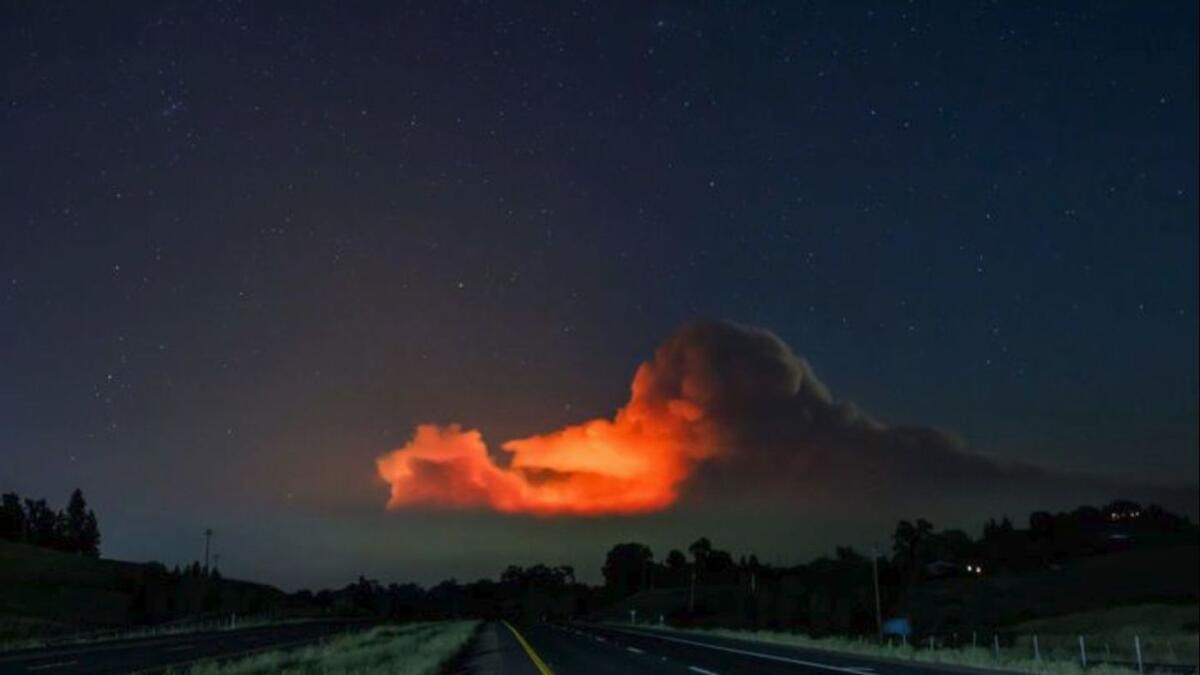
The Mendocino Complex fire has burned its way into the history books as the biggest fire ever recorded in California.
That is saying something given how destructive the fire year has been in the state.
But that distinction needs to be put in context. The fire, while massive, has destroyed far less property than other recent infernos. The wine country fires last year, while smaller in size, killed more than 40 people and destroyed thousands of homes.
The Mendocino Complex fire has burned more than 283,000 acres and was only 30% contained Monday night.
- Share via
As Trump tweets about California fires, his administration wants to expand logging
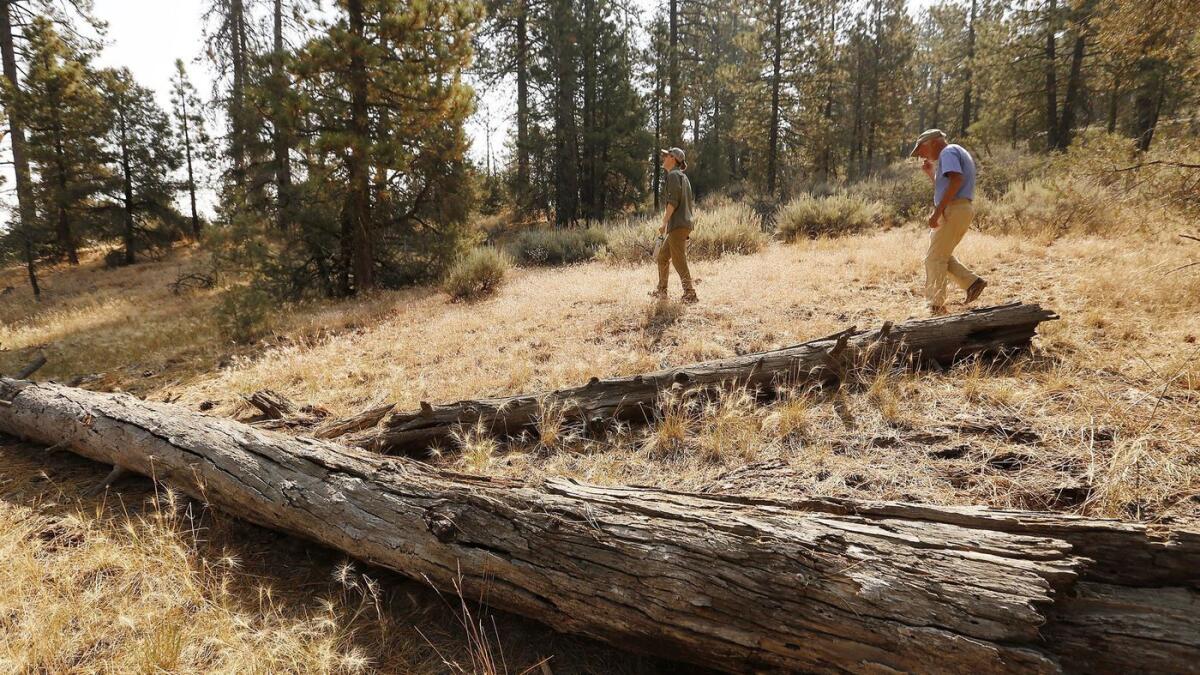
Logging has long been among California’s most divisive environmental issues — and the controversy shows little chance of cooling as the Trump administration pushes new efforts to thin forests.
The federal government is moving to allow commercial logging of healthy green pine trees for the first time in decades in the Los Padres National Forest north of Los Angeles, a tactic the U.S. Forest Service says will reduce fire risk. It’s an idea President Trump appeared to endorse in tweets inaccurately linking wildfire to state water management.
“California wildfires are being magnified & made so much worse by the bad environmental laws which aren’t allowing massive amounts of readily available water to be properly utilized,” Trump tweeted Sunday. “It is being diverted into the Pacific Ocean. Must also tree clear stop fire spreading!”
- Share via
Did you evacuate for a California wildfire? Tell us what you took with you
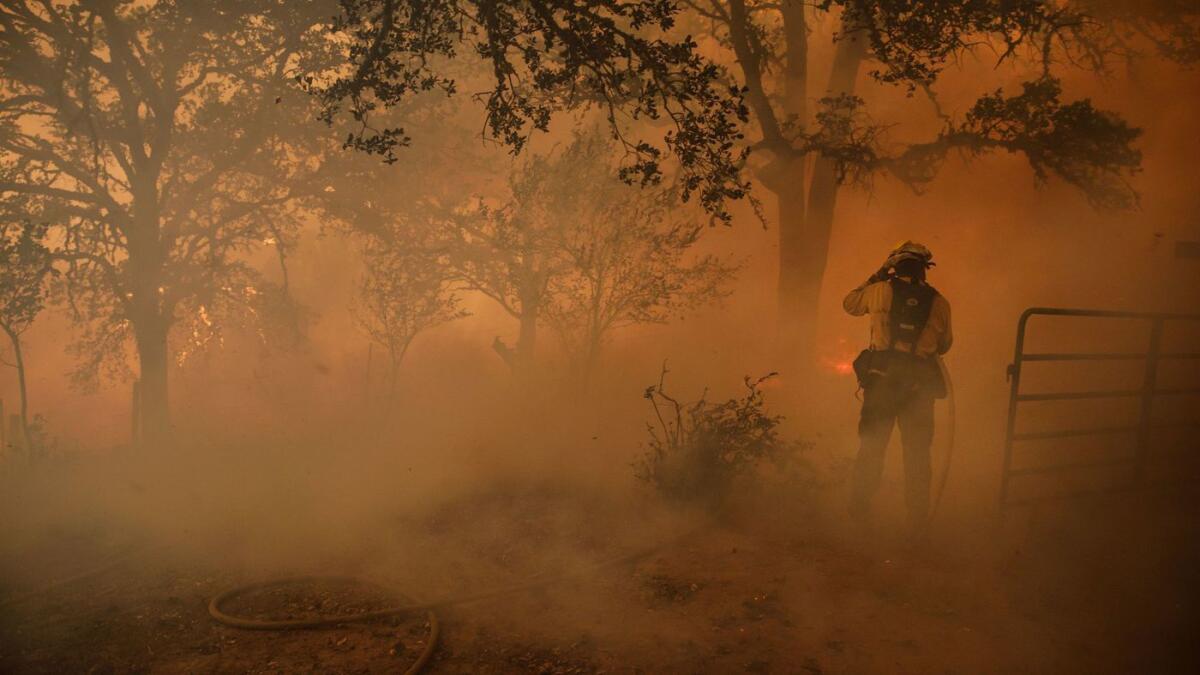
Californians are being forced to evacuate as wildfires burn around the state. As of Thursday, state officials said more than 13,000 firefighters were battling 16 blazes that have forced more than 32,000 residents to evacuate.
If you’ve been asked to evacuate your home, we want to hear from you: What did you take with you, and why?